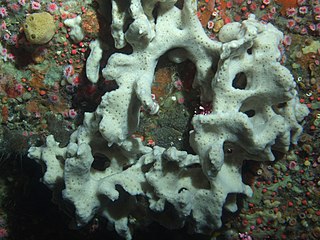
Geodia is a genus of sea sponge belonging to the family Geodiidae. It is the type genus of its taxonomic family.

Polymastia is a genus of sea sponges containing about 30 species. These are small to large encrusting or dome-shaped sponges with a smooth surface having many teat-shaped projections (papillae). In areas of strong wave action, this genus does not grow the teat structures, but instead grows in a corrugated form.

Halichondria is a genus of sea sponges belonging to the family Halichondriidae. These are massive, amorphous sponges with clearly separated inner and outer skeletons consisting of bundles of spicules arranged in a seemingly random pattern.

Axinella is a genus of sponges in the family Axinellidae first described in 1862 by Eduard Oscar Schmidt. Species of Axinella occur in the Indian and Pacific Oceans. Most of these sponges are smaller than 20 cm, and have a yellow or orange colour.
Hymeniacidon is a genus of sea sponges in the class Demospongiae. Some members of the genus are known to be mobile, achieving speeds of between 1 and 4 mm per day.
Stelletta is a genus of sea sponges belonging to the family Ancorinidae.

Clathria is a large genus of demosponges in the family Microcionidae.

Echinoclathria is a genus of demosponge in the family Microcionidae.
Biemna is a genus of sea sponges in the family Biemnidae.

Haliclona is a genus of demosponges in the family Chalinidae.

Ircinia is a genus of sea sponges in the family Irciniidae.
Dictyodendrillidae is a family of sponges in the order Dendroceratida.

Myxilla is a genus of demosponge belonging to the family Myxillidae. These sponges usually form encrustations on rock surfaces.

Callyspongia is a genus of demosponges in the family Callyspongiidae.

Crella is a genus of marine demosponges in the family Crellidae.

Craniella is a genus of marine sponges in the family Tetillidae.

Tedania is a genus of sea sponges in the family Tedaniidae.

Mycale is a genus of demosponge with 240 recognised species in 11 subgenera. It has been a large genus with multiple subdivisions since it was first described in 1867.

Antho is a genus of sponges belonging to the family Microcionidae. The genus has a cosmopolitan distribution and is known from virtually all parts of the global ocean. There are 62 species in five subgenera.

Phorbas is a genus of demosponges belonging to the family Hymedesmiidae.
















